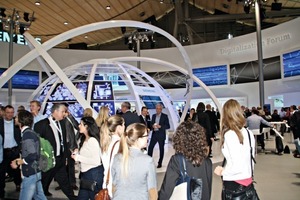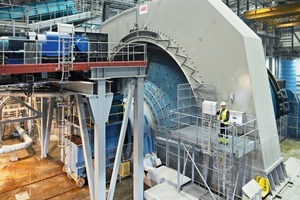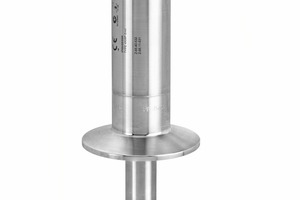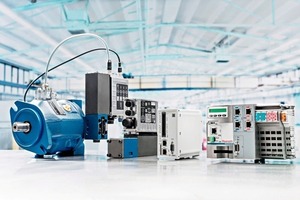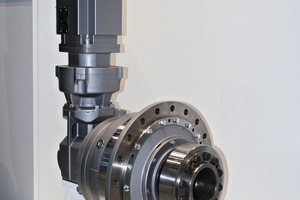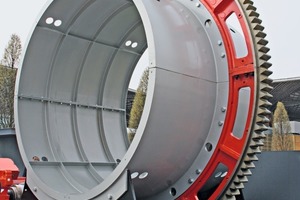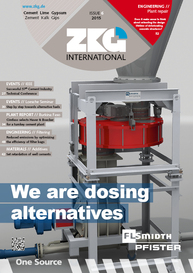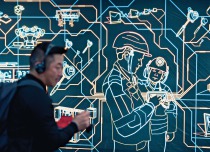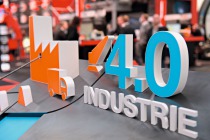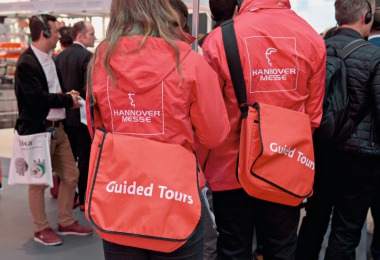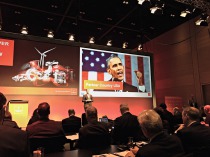Integrated industry takes Hannover Messe to new heights
After five action-packed days of industrial innovation, dynamic networking and lead generation, this year’s Hannover Messe – the world’s leading trade fair for industrial technology – drew to a close on 17.04.2015, to rave reviews by exhibitors and visitors. With “Integrated Industry – Join the Network” as its keynote theme, the event soared to new heights, striking an inspirational note among exhibitors and attendees from industry, business and government. The show placed major emphasis on the digitization of manufacturing, human-machine collaboration, innovative subcontracting solutions and smart energy systems – topics which pulled in the crowds (Fig. 1). More than 220 000 trade visitors – including around 70 000 from outside Germany – used the fair to catch up on the latest technical developments and make key investment decisions. Some 6500 companies from 70 countries showcased technologies for tomorrow’s production facilities and energy systems.
“The 2015 Hannover Messe has made it abundantly clear: Industry 4.0 has arrived, and is sweeping every sector of industry. Digital integration is becoming a key aspect of modern manufacturing, and this trend is set to continue at a rapid pace,” commented Dr. Jochen Köckler, member of the Management Board at the organizer Deutsche Messe.
Under the motto of “Integrated Industry – Join the Network”, the fair gave tangible shape to the vision of the “smart factory”. In the factory of the future, information will be smoothly interchanged between machines and products, ensuring optimum results and peak efficiency. According to Köckler, the 2015 Hannover Messe has demonstrated that “Industry 4.0” is far more than an inspirational buzzword – it is a reality. For the first time, the smart-factory solutions on display here can be purchased for immediate implementation in customers’ plants.
The pulling power of Industry 4.0 was also highly evident in the enthusiastic demand for guided tours, forums and events addressing the topic at the fair. “The 4.0-related tours for visitors were booked solid, as was the Industry 4.0 forum. And we ran out of copies of the Industry 4.0 visitor guide in the first few hours”, said Köckler. The supporting program of panel discussions and events also proved highly popular.
Integration is not confined solely to production operations, however: energy systems are also rapidly becoming “smart”, driving the transition to renewable forms of energy. An increasing number of decentralized power generators – including wind, solar, hydroelectric and biogas plants – are being hooked up to the grid. “The challenge of combining all these forms of energy generation into a single smart power grid, and distributing this power efficiently and reliably to consumers, has been impressively addressed by the many exhibitors showcasing their pioneering solutions for the energy sector at the Hannover Messe,” Köckler noted.
Only a few companies are spotlighted below, and may be considered to represent the large total number of exhibitors. The major multinational group ABB, domiciled in Zurich/Switzerland, for instance, showed a whole series of innovations which are potentially of interest to the cement, lime and gypsum industry. These include, in addition to drive systems (Fig. 2) and electronic equipment, such as IE4 synchronous reluctance motors and frequency converters, in particular, equipment and tools to improve the energy-efficiency of facilities, their control and maintenance, and new software developments for safety systems and their integration into the automation process. There are also new implementations, in the form of Apps and measuring units, to assist in progressive digitization and automatic electronic communication between individual modules.
Dr. Franz Muschaweck’s family-managed DALOG® company highlighted its diagnosis systems and data loggers for machine and process monitoring. The hardware and software, also developed with the cement industry in mind - for monitoring of rotary kilns, for example - provides customised solutions for machine diagnosis. The company, with registered offices in Neusäß, near Augsburg, also performs measuring projects for customers, including project planning, implementation and evaluation. ZKG will examine the function and benefits of these systems and their software in a special article to be published during mid-2015.
Endress + Hauser, the measuring specialists from Weil-on-the-Rhine, in Germany’s most south-westerly corner, now have, inter alia, an optimized filling-level monitoring system which supplies reliable measured data on liquid levels even under difficult conditions. The Liquiphant FTL 31 and FTL 33 (Fig. 3) are of compact and robust construction and can be ordered on-line. The Proline 200 flow meter, which uses the Coriolis principle to measure the quantities of material passed through it, is not totally new, but it is now also available in nominal diameter DN 80. Undoubted new developments at E+H are sensors and measuring probes in which power supply and data transfer are based on the induction principle. Corrosive substances can therefore no longer attack the connecting wiring. These instruments are fully enclosed and the “measuring head” can be easily replaced.
Large-scale gearing manufacturer Renk, of Augsburg, exhibited a revised and improved version of its COPE drive system, developed in cooperation with the Düsseldorf mill manufacturer Loesche for vertical mills. The individual drive units have now been made even more easily accessible for servicing and overhaul purposes by mounting the motor on a slide which the service technician then only has to pull out of the housing.
Like numerous other organisations, Rexroth AG, based in Lohr am Main and part of the Bosch group, has set itself the task of developing solutions for Industry 4.0. New “smart” hydraulic systems, which operate more energy-efficiently and can, above all, be networked, should also be of great interest to the industry (Fig. 4).
Siemens unveiled a whole range of new software and circuitry developments which will not only meet the needs of Industry 4.0, but also contribute to energy-efficiency and durability. ZKG will, as usual, focus individually on specific products, where this has not already taken place, as in the case of the Planurex 3 series of new planetary gearing systems (Fig. 5 and 6).
SEW Eurodrive, of Bruchsal, exhibited, inter alia, the world’s first mechatronic industrial gearbox. This cleverly integrates all the necessary components, from the prime mover, via the gearing mechanisms and control electronics, into a sealed system. The manufacturer notes that these systems are particularly suitable for conveying applications. Also on show were the fully revised planetary gearboxes of the XP series (Fig. 7), which have a modular structure and cover a torque range from 600 to 5200 kNm. These units can be used wherever high power outputs are handled – in ball mills and large tracked-vehicle transmission systems, for instance.
The exhibiting companies were unanimous that this year’s Hannover Messe had been a resounding success for them. Everyone interviewed responded in terms of “We almost lost count of the visitors to our stand” or “Demand for our products was simply overwhelming”. This satisfaction with the course of the event was reflected in high volumes of orders placed during the fair or expected in the very near future.
The next Hannover Messe will be held from 25. – 29.04.2016.
//www.hannovermesse.de" target="_blank" >www.hannovermesse.de:www.hannovermesse.de

